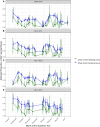Implementation of a Prospective Index-Cluster Sampling Strategy for the Detection of Presymptomatic Viral Respiratory Infection in Undergraduate Students
- PMID: 38440301
- PMCID: PMC10911223
- DOI: 10.1093/ofid/ofae081
Implementation of a Prospective Index-Cluster Sampling Strategy for the Detection of Presymptomatic Viral Respiratory Infection in Undergraduate Students
Abstract
Background: Index-cluster studies may help characterize the spread of communicable infections in the presymptomatic state. We describe a prospective index-cluster sampling strategy (ICSS) to detect presymptomatic respiratory viral illness and its implementation in a college population.
Methods: We enrolled an annual cohort of first-year undergraduates who completed daily electronic symptom diaries to identify index cases (ICs) with respiratory illness. Investigators then selected 5-10 potentially exposed, asymptomatic close contacts (CCs) who were geographically co-located to follow for infections. Symptoms and nasopharyngeal samples were collected for 5 days. Logistic regression model-based predictions for proportions of self-reported illness were compared graphically for the whole cohort sampling group and the CC group.
Results: We enrolled 1379 participants between 2009 and 2015, including 288 ICs and 882 CCs. The median number of CCs per IC was 6 (interquartile range, 3-8). Among the 882 CCs, 111 (13%) developed acute respiratory illnesses. Viral etiology testing in 246 ICs (85%) and 719 CCs (82%) identified a pathogen in 57% of ICs and 15% of CCs. Among those with detectable virus, rhinovirus was the most common (IC: 18%; CC: 6%) followed by coxsackievirus/echovirus (IC: 11%; CC: 4%). Among 106 CCs with a detected virus, only 18% had the same virus as their associated IC. Graphically, CCs did not have a higher frequency of self-reported illness relative to the whole cohort sampling group.
Conclusions: Establishing clusters by geographic proximity did not enrich for cases of viral transmission, suggesting that ICSS may be a less effective strategy to detect spread of respiratory infection.
Keywords: college health; disease transmission; respiratory viral illness; surveillance.
© The Author(s) 2024. Published by Oxford University Press on behalf of Infectious Diseases Society of America.
Conflict of interest statement
Potential conflicts of interest. M. T. M. reports grants from the Defense Advanced Research Projects Agency (DARPA) and the National Institutes of Health (NIH), and has a patent pending on “Methods to diagnose and treat acute respiratory infections.” T. W. B. reports grants from DARPA and NIH; reports owning equity in and serving as a consultant for Biomeme; and has a patent pending on Methods to diagnose and treat acute respiratory infections. E. L. T. reports consultancy fees and equity from Biomeme; has patents pending on Biomarkers for the molecular classification of bacterial infection and Methods to diagnose and treat acute respiratory infections; and is currently an employee of Danaher Diagnostics. C. W. W. and G. S. G. have patents pending on Molecular classification of bacterial infection and gene expression signatures useful to predict or diagnose sepsis and methods of using the same, and have patents issued on Methods to diagnose and treat acute respiratory disease and Methods of identifying infectious disease and assays for identifying infectious disease. C. W. W. reports owning equity in and consulting for Biomeme; reports grants from DARPA, NIH, Antibacterial Resistance Leadership Group, and Sanofi; and has received consultancy fees from bioMérieux, Roche, Biofire, Giner, and Biomeme. All other authors report no potential conflicts.
Figures


Similar articles
-
A blood-based host gene expression assay for early detection of respiratory viral infection: an index-cluster prospective cohort study.Lancet Infect Dis. 2021 Mar;21(3):396-404. doi: 10.1016/S1473-3099(20)30486-2. Epub 2020 Sep 24. Lancet Infect Dis. 2021. PMID: 32979932 Free PMC article.
-
Assessment of the Feasibility of Using Noninvasive Wearable Biometric Monitoring Sensors to Detect Influenza and the Common Cold Before Symptom Onset.JAMA Netw Open. 2021 Sep 1;4(9):e2128534. doi: 10.1001/jamanetworkopen.2021.28534. JAMA Netw Open. 2021. PMID: 34586364 Free PMC article.
-
Effectiveness and cost-effectiveness of four different strategies for SARS-CoV-2 surveillance in the general population (CoV-Surv Study): a structured summary of a study protocol for a cluster-randomised, two-factorial controlled trial.Trials. 2021 Jan 8;22(1):39. doi: 10.1186/s13063-020-04982-z. Trials. 2021. PMID: 33419461 Free PMC article.
-
Universal screening for SARS-CoV-2 infection: a rapid review.Cochrane Database Syst Rev. 2020 Sep 15;9(9):CD013718. doi: 10.1002/14651858.CD013718. Cochrane Database Syst Rev. 2020. PMID: 33502003 Free PMC article.
-
Occurrence and transmission potential of asymptomatic and presymptomatic SARS-CoV-2 infections: A living systematic review and meta-analysis.PLoS Med. 2020 Sep 22;17(9):e1003346. doi: 10.1371/journal.pmed.1003346. eCollection 2020 Sep. PLoS Med. 2020. PMID: 32960881 Free PMC article.
References
-
- Nichol KL, D’Heilly S, Ehlinger E. Colds and influenza-like illnesses in university students: impact on health, academic and work performance, and health care use. Clin Infect Dis 2005; 40:1263–70. - PubMed
-
- Tsuang WM, Bailar JC, Englund JA. Influenza-like symptoms in the college dormitory environment: a survey taken during the 1999–2000 influenza season. J Environ Health 2004; 66:39–42, 44. - PubMed

